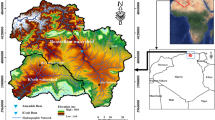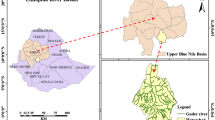Abstract
Soil erosion is a geo-ecological problem in Southwest China, which can result in karst rocky desertification when it is very serious. The grade delineation of soil erosion risk can be used as a guide for controlling regional and hierarchical soil erosion, and provide scientific references for restraining rocky desertification. Chaotian Town, an area of Karst Mountains and hills in Guilin, northeast part of Guangxi Zhuang Autonomous Region, China, was chosen as the study area. Settlement buffer, roadway buffer, lithology, slope, elevation, and aspect were selected as the main indicators of soil erosion in the karst area. After the indicators were scored by fuzzy modeling, the potential risk of soil erosion was quantified using indicator-weight union method. Five grades of soil erosion risk were delineated based on Geographic Information System. The grades of minimal, low, medium, high, and extreme soil erosion risk accounted for 1.62, 19.46, 52.35, 24.86, and 1.71 %, respectively. As a whole, the soil erosion risk was moderate, because the proportion data of different grades of soil erosion risk were a normal distribution, and about 52.35 % of the study area was in the medium grade. Soil erosion risk was higher in the southeast of the study area and lower in the northwest. Obvious variances have been found in the grade distribution of soil erosion risk, corresponding to different indicators.



Similar content being viewed by others
References
Andrews SS, Mitchell JP, Mancinelli R, Karlen KL, Hartz TK, Horwath WR, Pettygrove GS, Scow KM, Munk DS (2002) On-farm assessment of soil quality in California’s central valley. Agron J 94:12–23
Cai Y (1997) Ecological and socio-economic rehabilitation in the karst of Southwest China. J Chin Geogr 7:24–32 (in Chinese with English abstract)
Doran JW, Parkin BT (1994) Defining and assessing soil quality. In: Doran JW, Coleman DC, Bezdicek DF, Stewart BA (eds) Defining soil quality for a sustainable environment. Soil Science Society of America, Inc., Madison, pp 3–21 (Special Publication. Number 35)
Hesse R, Jetten V (2007) Suitability of transport equations in modelling soil erosion for a small Loess Plateau catchment. Eng Geol 91:56–71
Hoyos N (2005) Spatial modeling of soil erosion potential in a tropical watershed of the Colombian Andes. Catena 63:85–108
Huang QH, Cai YL (2007) Spatial pattern of karst rock desertification in the Middle of Guizhou Province, Southwestern China. Environ Geol 52:1325–1330
Jiang YJ, Li LL, Groves C, Yuan DX, Kambesis P (2009) Relationships between rocky desertification and spatial pattern of land use in typical karst area, Southwest China. Environ Earth Sci 59:881–890
Karlen DL, Scott DE (1994) A framework for evaluating physical and chemical indicators of soil quality. In: Doran JW, Coleman DC, Bezdicek DF, Stewart BA (eds) Defining soil quality for a sustainable environment. ASA and SSSA, Madison, pp 53–72
Kefi M, Yoshino K, Setiawan Y (2012) Assessment and mapping of soil erosion risk by water in Tunisia using time series MODIS data. Paddy Water Environ 10:59–73
Lai VS, Wong BK, Cheung W (2002) Group decision making in a multiple criteria environment: a case using the AHP in software selection. Eur J Oper Res 137:134–144
Lal R (2003) Soil erosion and the global carbon budget. Environ Int 29:437–450
Li YB, Wang SJ, Li RL (2004) Preliminary study on karst rocky desertification genesis in Huajiang gorge district. Hydrogeol Eng Geol 31(6):37–42
Li YB, Shao JA, Yang H, Bai XY (2009) The relations between land use and karst rocky desertification in a typical karst area. China Environ Geol 57:621–627
Liu YS, Wang JY, Deng XZ (2008) Rocky land desertification and its driving forces in the karst areas of rural Guangxi. Southwest China 5:350–357
Nisar Ahamed TR, Gopal Rao K, Murthy JSR (2000) GIS-based fuzzy membership model for crop-land suitability analysis. Agric Syst 63:75–95
Paidamwoyo M, Kakembo V, Lim KJ (2012) Soil erosion risk assessment of the Keiskamma catchment. South Africa using GIS and remote sensing. Environ Earth Sci 65:2087–2102
Prasannakumar V, Vijith H, Abinod S, Geetha N (2012) Estimation of soil erosion risk within a small mountainous sub-watershed in Kerala, India, using Revised Universal Soil Loss Equation (RUSLE) and geo-information technology. Geosci Front 3(2):209–215
Renard KG, Foster GR, Weesies GA, McCool DK, Yoder DC (1997) Predicting soil erosion by water: a guide to conservation planning with the revised universal soil loss equation (RUSLE). In: USDA Handbook, vol. 703. US Department of Agriculture, Washington, DC
Saaty TL (1977) A scaling method for priorities in hierarchical structures. J Math Psychol 15:234–281
Sanjay K, Jain Sudhir Kumar, Varghese Jose (2001) Estimation of soil erosion for a himalayan watershed using GIS technique. Water Resour Manag 15:41–54
Shi XZ, Wang K, Warner ED, Yu DS, Wang HJ, Yang RW, Liang Y, Shi DM (2007) Relationship between soil erosion and distance to roadways in undeveloped areas of China. Catena 72:305–313
Su WC, Yang H, Li Q (2006) Rocky land desertification and its controlling measurements in the karst mountainous region, Southwest of China. Chin J Soil Sci 37(3):446–450 (in Chinese with English abstract)
Wang DL, Yu LF (2005) The quantitative assessment of ecological frangibility in karst areas. J Nanjing For Univ Nat Sci Ed 29(6):23–26
Wang GGG, Fang S, Anderson AB (2003) Mapping multiple variables for predicting soil loss by geostatistical methods with TM images and a slope map. Photogramm Eng Remote Sens 69:889–898
Wang S, Liu Q, Zhang D (2004) Karst rock desertification in Southwestern China: geomorphology, land use, impact and rehabilitation. Land Degrad Dev 15:115–121
Xiong YJ, Qiu GY, Mo DK, Lin H, Sun H, Wang QX, Zhao SH, Yin J (2008) Rocky desertification and its causes in karst areas: a case study in Yongshun County, Hunan Province, China. Environ Geol 57:1481–1488
Xu YQ, Shao XM, Kong XB, Peng J, Cai YL (2008) Adapting the RUSLE and GIS to model soil erosion risk in a mountains karst watershed, Guizhou Province, China. Environ Monit Assess 141:275–286
Yang QY, Li JB, Wang KL, Xie JN (2007) Comprehensive evaluation of water resource development on AHP in Hu’nan province. Bull Soil Water Conserv 27(2):150–153 (in Chinese with English abstract)
Yang QY, Yang JS, Yao RJ, Huang B, Sun WX (2010) Comprehensive evaluation of soil fertility by GIS and improved grey relation model. Trans CSAE 26:100–105 (in Chinese with English abstract)
Yuan D (1993) The Karst study of China. Geology Press, Beijing
Zhang B, Zhang Y, Chen D, White RE, Li Y (2004) A quantitative evaluation system of soil productivity for intensive agriculture in China. Geoderma 123:319–331
Zhang PP, Hu YM, Xiao DN (2010) Rocky desertification risk zone delineation in karst plateau area: a case study in Puding County, Guizhou Province. Chin Geogra Sci 20(1):084–090
Zhang MY, Wang KL, Liu HY, Zhang CH (2011) Responses of spatial-temporal variation of karst ecosystem service values to landscape pattern in northwest of Guangxi, China. Chin Geogra Sci 21(4):446–453
Acknowledgments
This research was supported by the National science and technology support program (NO. 2012BAC16B02), the Guangxi Natural Science Foundation (NO. 2012GXNSFAA053186), the Remote Sensing Survey and Ground Monitoring on Karst Rocky Desertification in Southwest China (NO. 1212011220958), the Ministry of Water resources of China (Grant No. 2005SBKK05), the Ministry of Science and Technology of China (Grant No. 2010BAE00739), and the Institute of Karst Geology, CAGS (Grant No. 2012015). We would also like to thank Dr. James W. LaMoreaux for his valuable comments and Ms. Lily Zeng for polishing the English language of the paper, which greatly improved the original manuscript.
Author information
Authors and Affiliations
Corresponding author
Rights and permissions
About this article
Cite this article
Yang, Q., Xie, Y., Li, W. et al. Assessing soil erosion risk in karst area using fuzzy modeling and method of the analytical hierarchy process. Environ Earth Sci 71, 287–292 (2014). https://doi.org/10.1007/s12665-013-2432-x
Received:
Accepted:
Published:
Issue Date:
DOI: https://doi.org/10.1007/s12665-013-2432-x




